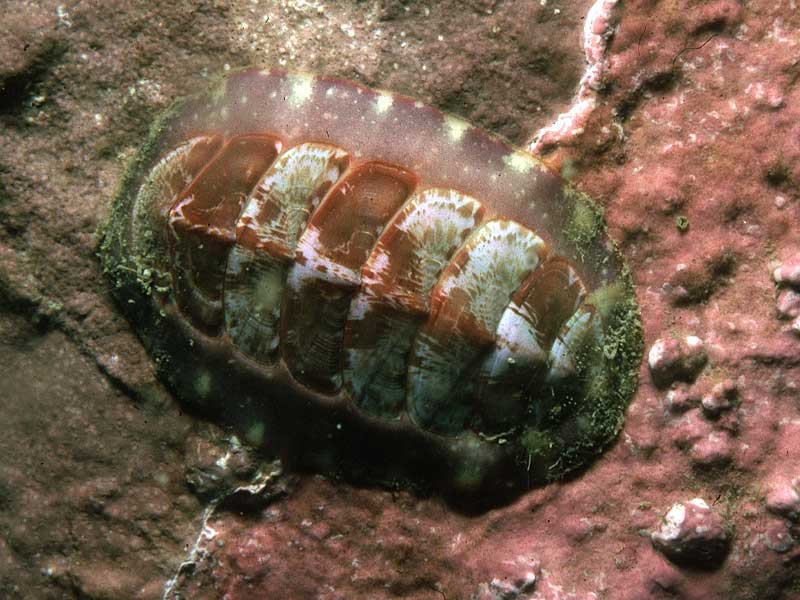Northern Ireland Priority species (NIPS)
| MOLLUSCA : Chitonida : Tonicellidae | SNAILS, SLUGS, ETC. |
Tonicella marmorea (O. Fabricius, 1780)
 |
| Tonicella marmorea |
This large attractive chiton is found only in the northern part of Ireland and Britain. Northern Ireland holds the entire Irish population, which is regarded as declining.
In brief
- It is common only in Strangford Lough in Northern Ireland
- It can be found all year round under stones or rocks low on the shore, or by diving
- The entire Irish population is within Northern Ireland
- It is thought to be declining, possibly due to climate change.
Species description: A large, broadly oval ‘limpet-like’ chiton, up to 4cm in length. The eight arched shell plates are smooth (covered with numerous minute granules) and glossy, light red to dark brick red or chestnut brown in colour with variable white or fawn marbling. Adjacent valves may have contrasting colours, typically as in the photograph. The fleshy girdle around the edge is broad, thin and smoothly leathery, reddish-brown with a fringe of tiny, flattened spines (red, green or purple in colour, sometimes banded).
Life cycle: Chitons have separate sexes, with fertilisation occurring externally, with both eggs and sperm being released into the sea water. After fertilization, a larval trochophore develops and then metamorphoses directly into a juvenile.
Similar species: There are several similar species: Callochiton septemvalvis, Tonicella rubra and pink forms of Lepidochitona cinerea. Tonicella marmorea is distinguished by having a smooth, broad girdle, not coarsely granular, scaly or with tufts of bristles. The shell valves are smooth and glossy, and normally a rich chestnut red/brown colour (not pink), and marbled with white.
How to see this species: This herbivorous chiton is found all year round on rocky shores and in the sublittoral to at least 40m around the coast of Northern Ireland from Carlingford Lough to Rathlin Island, but particularly in Strangford Lough. Commonly, it lives under stones and boulders in muddy gravel, close to low water on the shore, in areas of shelter from current or wave action, rarely on the open coast. It is a herbivorous grazer of microalgae. In the sublittoral, it is usually on silty muddy bedrock or large boulders.
Current status: Tonicella marmorea was found commonly throughout Strangford Lough in the late 1980s and early 1990s, with up to a dozen animals found at any single site. Since that date, anecdotal evidence suggests that while single animals may still occasionally be found at most sites, there are substantially reduced populations. It is a northern species found elsewhere predominantly in Scotland, where it can occur in high densities in sea lochs, and northern England. It is a widespread Atlantic-Boreal species.
Why is this species a priority in Northern Ireland?
- Northern Ireland currently holds the entire Irish population, which is thought to be declining and is scarce.
Threats: The major threat to this species is thought to be climate change, that is, global warming. Tonicella marmorea is a northern species at the limits of its range in Northern Ireland.
Distribution Map from NBN: Tonicella marmorea at National Biodiversity Network mapping facility, data for UK.
iNaturalist: Tonicella marmorea at iNaturalist World Species Observations database.
WoRMS: Tonicella marmorea at World Register of Marine Species. Accepted name: Tonicella marmorea (O. Fabricius, 1780). AphiaID: 140151.
Classification: Biota; Animalia; Mollusca; Polyplacophora; Neoloricata; Chitonida; Acanthochitonina; Mopalioidea; Tonicellidae; Tonicellinae; Tonicella
| Previous species | Next species |
| Authors (2024). Tonicella marmorea. (O. Fabricius, 1780). [In] Priority species, Marine Biodiversity Portal NI. https://www2.habitas.org.uk/marbiop-ni/priorityaccounts.php?item=W780. Accessed on 2025-04-19 |